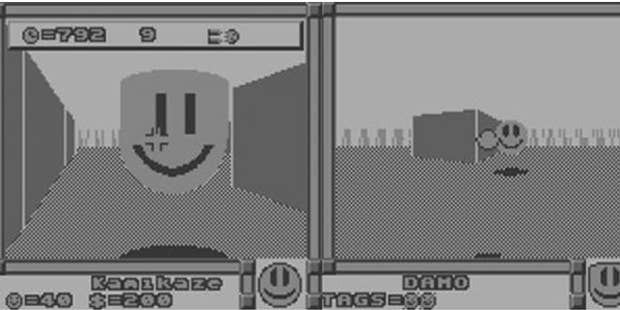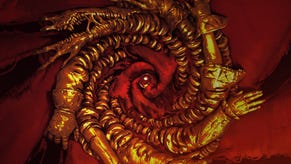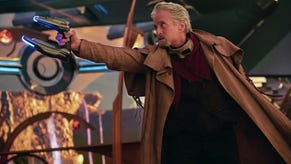The Game Boy's First-Person Shooter (And Other Stories From an Ill-Starred Sub-Genre)
Handheld platforms may not be particularly well-suited for first-person shooters, but it's not for want of trying.
This article first appeared on USgamer, a partner publication of VG247. Some content, such as this article, has been migrated to VG247 for posterity after USgamer's closure - but it has not been edited or further vetted by the VG247 team.
Before Wolfenstein 3D popularized first-person shooters on the PC, and DOOM caused them to explode, there was Faceball 2000.
Quietly released in 1991, it accomplished a rather remarkable technical feat on the Game Boy—3D graphics. The framed screen wasn't much larger than a postage stamp, but there was no denying that it was a first-person shooter, even if it wasn't exactly Call of Duty. It even supported up to 16-players at once, which was a feat that wouldn't be repeated on home consoles until Halo came around a decade later.

These days, Wolfenstein 3D and DOOM are far better known than Faceball 2000; but in a strange way, the funny little shooter by Xanth Software F/X may have a more direct connection to the genre's roots. After all, Faceball 2000 is a direct descendant of the Atari ST's Midi Maze, which itself owes a large debt to what may be the first FPS ever made—1974's Maze War.
Who knew?
Handheld first-person shooters, of course, have come a long way since the days of Faceball 2000. But in a way, ports like Borderlands 2 on the PlayStation Vita really aren't that from their early counterparts. Even now, they're typically little more than sideshows—a sub-genre that gets trotted out by Sony and its ilk because it serves as useful short-hand for, "We've managed to make this amazing AAA experience portable! Sure it's cumbersome to play, suffers from a terrible framerate, and barely functions as it was originally intended; but if you try hard enough, you can pretend that you're getting the same experience on your Vita as you would on your PlayStation 4."
Sure, games like Killzone: Mercenaries occasionally get held up as beacons of progress (and Killzone isn't even that bad, either). But by and large, it's more fun to remember the curiosities among handheld first-person shooters than the failed attempts to match up with home consoles. These are a few of my favorites.
Tyrannosaurus Tex (Game Boy Color)
What a name. Just it sink of a few seconds—Tyrannosaurus Tex. If the Game Boy Color's only real first-person shooter had to be named anything, I'm glad it's that. The planned boxart is equally amazing.
Developed by Ben John, a Colony Wars programmer who was deeply in love with the Game Boy, it was a bit of a technical marvel in its day. According to Nintendo Player, which has a lengthy feature on the subject, John's demo manage to impress Take 2 Interactive, Codemasters, and THQ before it was snapped up by Eidos. Teaming with arist Dan Crawley and producer Iain McNeill, who ended up leaving Eidos to form Slitherine Software with Crawley and John, they went to work on what was to be one of the Game Boy Color's only 3D games.
Unfortunately for John and company, it didn't end well. Tex was an exceptionally ambitious game, even by today's standards, with a planned 40 hours of content and multiplayer. With its highly detailed sprites—much like Doom and Wolfenstein 3D, Tex mimicked 3D by drawing in 2D art—and pseudo-3D sound, it pushed the Game Boy Color the absolute limit. Like X before it, it had a decent chance of at least being an interesting technical achievement, if not an outright hit. In the end though, it never made it to market.
Timing and technical hurdles were ultimately what took down Tex. With costs and delays stemming from Tex's overwhelming ambition steadily mounting, Eidos eventually dropped the project. With the Game Boy Advance on the horizon, Tex was turned down by SCi Entertainment, Telegames, and Take 2. John reportedly ended up fleeing the country, taking the source code with him. It was a surreal end to a project that had once had so much promise.
There is a happy ending of sorts, though. In early 2013, a prototype appeared on eBay, which was soon dumped onto a ROM and uploaded to the Internet. It may not have achieved its lofty ambitious; but in some sense at least, Tex lives on.
CyberVirus (Atari Lynx)
A few years before Ben John attempted Tyrannosaurus Tex on the Game Boy Color, an outfit called Beyond Games attempted their own first-person shooter on the Atari Lynx. Like John's effort, CyberVirus was eventually cancelled. But around 2003, CyberVirus managed to find a second life thanks in large part to the Lynx's vibrant independent development community.
Built on the engine of a similar game called Battlewheels, CyberVirus was a colorful albeit generic sci-fi shooter. Wearing goggles—a technique not unlike the one used in Faceball 2000—the player moves slowly across an alien landscape and battle robots. Though based on the same engine as Battlewheels, CyberVirus had more advanced controls, including the ability to sidestep. Nevertheless, it wasn't much more on a curiosity on a platform full of them.

Interestingly enough, the Lynx was better-suited for FPS development than most handhelds. Using similar techniques to those of the Afterburner-like Blue Lightning, developers could easily zoom and distort sprites for a pseudo-3D effect. This technique was used in a number of Lynx games, including Battlezone 2000 and the aforementioned Battlewheels.
Sadly, the Atari Lynx never amounted to much. Overshadowed by the Game Gear and the Game Boy, it quickly faded from store shelves and became the province of hobbyists. Nevertheless, the Lynx had a much stronger shooter library than either of its better-known competitors thanks to its deceptively powerful hardware. There's even a demo for a canceled Alien vs. Predator port floating around the Internet, and it's apparently shockingly good. Another instance of a platform finding new life long after its supposed sell-by date.
Duke Nukem Advance (Game Boy Advance)
I know I said that I wouldn't talk about ports here; but strictly speaking, Duke Nukem Advance isn't a port. It's a pseudo-sequel that borrows the art from the original game, but otherwise has its own levels and content.
One reason I bring it up is that I can't stress enough how weird it is that Duke Nukem 3D for the Game Boy Advance even exists. At the time, it was one of the bawdiest mainstream games around; a shooter where the protagonist would hand a dollar to a stripper and say, "Shake it baby." And this game was on the Game Boy Advance, where it presumably sat on retail shelves next to Hannah Montana and Spongebob Squarepants.

In case you're wondering, this isn't a case of moral panic on my part. I just find the very idea of Duke Nukem 3D on the Game Boy Advance—the Game Boy Advance!—inherently hilarious. After all, we're talking about Nintendo here; a company that occasionally bent under the pressure of allowing a truly crude M-rated game to be published on their platform (see: Conker's Bad Fur Day), but rarely broke.
And here's the really stunning part: It was actually a pretty good port! Though obviously not up to the standards of the original, which in its day was the most advanced of the old 2.5D shooters, it managed to squeeze in a good chunk of what made Duke Nukem 3D what it was. It even had a few voice samples containing Duke's famous one-liners.
Of course, as has been the case with pretty much every handheld system ever, the GBA wasn't exactly a suitable platform for a first-person shooter. Torus Games did its best with what it had, but the controls were still fairly rough, limited as they were to two face buttons, two shoulder buttons, and a D-pad. And though it had a few audio samples, it mostly had to rely on written text. It was an admirable effort, but one that didn't exactly play to the platform's strengths.
In the end, it wasn't even a "mature" shooter. Tagged with a Teen rating, it ended up losing the swearing, the strippers, and the bathroom humor. Maybe for the best, since it tended to overshadow what was in fact an excellent shooter for the time. But deep down, I love the idea of an M-rated shooter on the GBA. C'est la vie, I guess...
Dementium: The Ward (Nintendo DS)
... Oh, nevermind! Here's an M-rated shooter right here!
Dementium: The Ward (and its sequel—Dementium II) is perhaps the platonic ideal of the handheld first-person shooter. Picking up where Metroid Prime: Hunters left off with the Nintendo DS, it's an atmospheric, rather creepy little puzzle-shooter that deemphasizes raw skill while playing up adventure elements.
That approach is evident from the first few minutes of the game, when you're wheeled into a darkened hospital, then left to wander the blood-stained hallways with little more than a flashlight. It was short, but memorable, and one of the few handheld shooters that wanted to be more than a technical showpiece. Developer Renegade Kid eventually went on to develop the equally interesting Moon—a sci-fi shooter that is now being ported over to the Nintendo 3DS (I wrote about it a little while ago).
One thing that's funny to think about years after the fact is that the Nintendo DS arguably has a better shooter library than the more powerful PlayStation Portable, which was hyped at the time as essentially a portable PS2. Part of it is the superior control scheme, I think. The DS could be hand-crampingly awful at times, but it was by and large a better alternative than using the D-pad as a poor stand-in for a second analog stick. And the technology being what it was, the PSP seemed to attract more below-average ports and spinoffs.
Dementium: The Ward was slower; more puzzle-oriented, and generally more willing to play to its platform's strengths; and though it's largely forgotten, a pretty good survival horror shooter. That tells me it's possible to make a genuinely great handheld FPS, even if it's not the ideal platform for the genre.
Something tells me, however, that developers and publishers are going to continue to lean more in the direction of ports and spinoffs like Borderlands 2 than original, thoughtfully-designed content like Dementium: The Ward, if only because a lot of people still find the idea of a AAA-quality handheld shooter sexy. More's the pity.











